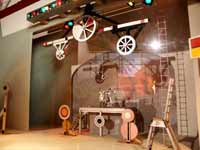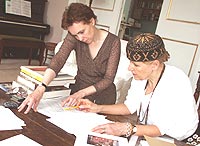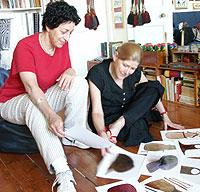
Model reconstruction of Yakoulov’s original
designs, by Lesley-Anne Sayers

Lesley-Anne Sayers and Millicent Hodson
|
This production will use an unpublished
scenario co-written by Soviet designer Georgi Yakoulov
and Serge Prokofiev in 1925. The original ideas for the
staging and narrative content were adapted for the ballet’s premiere by
Diaghilev’s Ballets Russes in 1927. This project aims
to present the ballet as collaboratively conceived in 1925. It
is therefore the first ever staging of the music alongside the
action it was written for.
Le Pas d’Acier is a series of scenes in two acts. The first
part is set in Russia during the period of famine, the second
in a factory. Through the interaction of music, movement and
design, the ballet explores the theme of social transition and
transformation, revolutionary ideals of empowerment through
industrialisation 'construction' and the Machine.




|
|
“Machines are worshipped
because they are beautiful, and valued because they
confer power; they are hated because they are hideous,
and loathed because they impose slavery”.
Bertrand Russell, 1928.
Le Pas d’Acier’s production history relates to this
key debate of the modern era. Born out of a desire to
explore the ideal of the machine for a revolutionary
future based on industrialization and the nobility of
labour, it was produced in a Western viewing context where
for many the
capitalist factory, as well as Bolshevik ideals,
represented exploitation and de-humanised, soul-less toil.
This new staging returns to the original collaboration
between composer and designer in 1925, to reconsider
Prokofiev's 'factory' in interaction with Yakoulov’s ‘factory’,
and to explore the work's innovative model of ballet as well
as the social ideals it embodies and represents.
|

Ze'eva Cohen, director of Princeton's Advanced Dance Program,
and Millicent Hodson
See: Lesley-Anne Sayers and Simon Morrison:
Prokofiev’s Le Pas d’Acier: How the Steel was Tempered,
Soviet Music and Society Under Lenin and Stalin: The Baton
and the Sickle, Neil Edmunds (ed)., Routledge-Curzon, UK,
2004, p.81-104.
See: Lesley-Anne Sayers: Re-Discovering
Diaghilev’s ‘Pas d’Acier’, Dance Research, The Journal
of the Society for Dance Research, UK, vol. 18, no. 2, Winter
2000, p.163-185.
|
The driving force behind the ballet’s original conception was
its designer, Georgi Yakoulov, a leading member of the Soviet
avant garde.
Prior to Prokofiev's first return visit to Russia in 1927, and
his eventual permanent return in 1936, Yakoulov brought
a re-connection
to artistic developments in Moscow, to the ideals of ‘construction’
and the machine, and to the Russian
approaches to staging associated with Alexander Tairov and Vsvold
Meyerhold.
Le Pas d’Acier was Diaghilev’s most radical interaction
with Constructivism, and is the only known ballet to have combined
a Soviet revolutionary theme with a Constructivist staging.
But the evidence suggests that the original staging could not resolve
the politically charged dilemmas of the subject matter, and
suffered from mixed sources of inspiration and
realisation (Soviet theatre
/ Ballets Russes). This project aims to re-connect the
ballet to its original sources in movement-based Soviet revolutionary
theatre and the influence of film in the 1920s.
Staging History.
1927: Diaghilev’s Ballets Russes, Paris and
London.Choreography: Leonid Massine. Design: Georgi Yakoulov
1931: The League of Composers, New York.
Choreography:
Edwin Strawbridge. Design: Lee Simonson
1948: Serge Lifar, Paris. Choreography: Serge
Lifar. Design: Fernand Leger
 
Links:
Georgi Yakoulov
Pas D'Acier Set Model
The
Serge Prokofiev Foundation
|